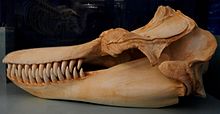Heterodontics


Heterodontics (anisodontics) ( ancient Greek ἕτερος 'different, different' and ancient Greek ὀδούς , Gen. ὀδόντος 'tooth' ) is the name for the presence of differently formed groups of teeth in a set of teeth . This is typical for mammals , so they usually have a differentiated set of incisors , canines , premolars and molars . The amniote line of the Synapsida , to which mammals belong, is characterized by an increasingly pronounced form of heterodontics. Some extinct archosaurs , such as Notosuchia or Heterodontosauriden , also have heterodontic teeth.
In contrast to heterodontics, there is homodontics , the original evolutionary- historical state of the teeth of terrestrial vertebrates . It is typical for amphibians and reptiles , but also occurs (secondarily) in mammals that do not process their food in the oral cavity, but swallow it without chewing . The toothed whales are a prime example of this .
literature
- Dagmar Reiche: Roche Lexicon Medicine 5th Edition. Elsevier, Munich 2003, ISBN 978-3-437-15150-7 , p. 86 ( Gesundheit.de ).